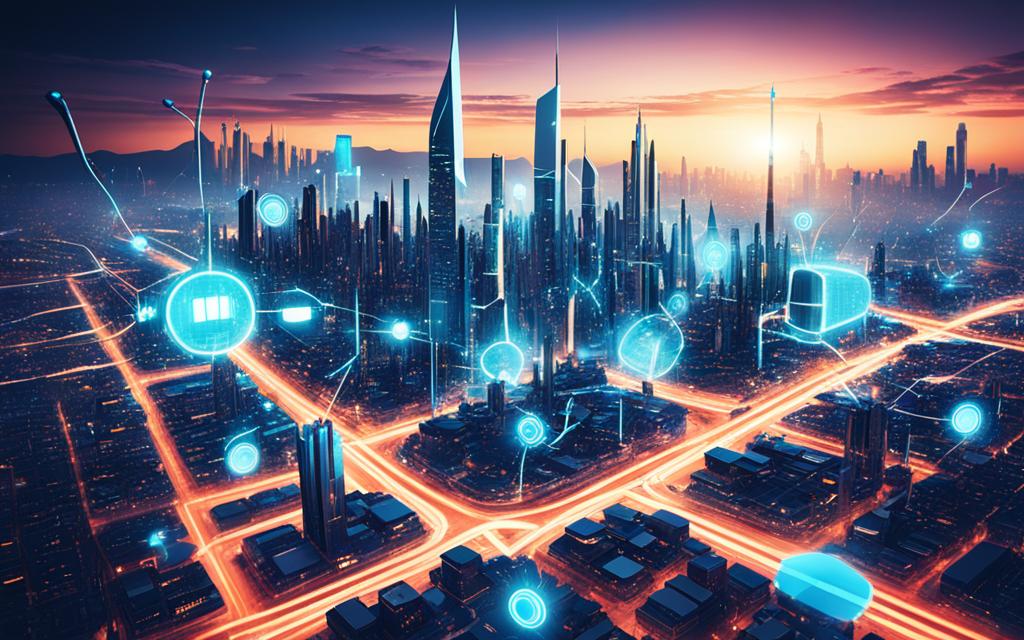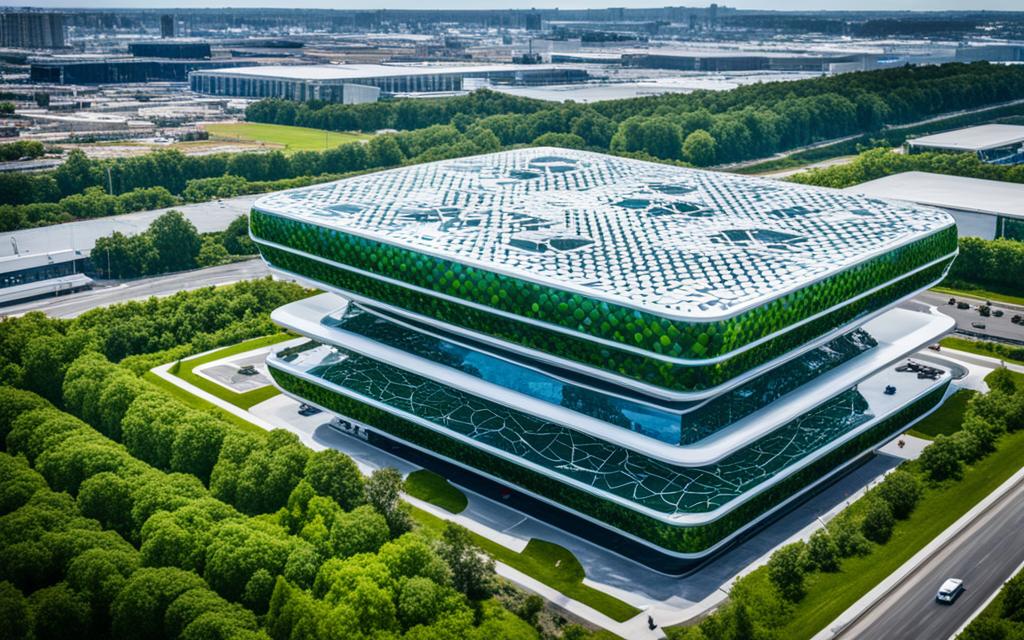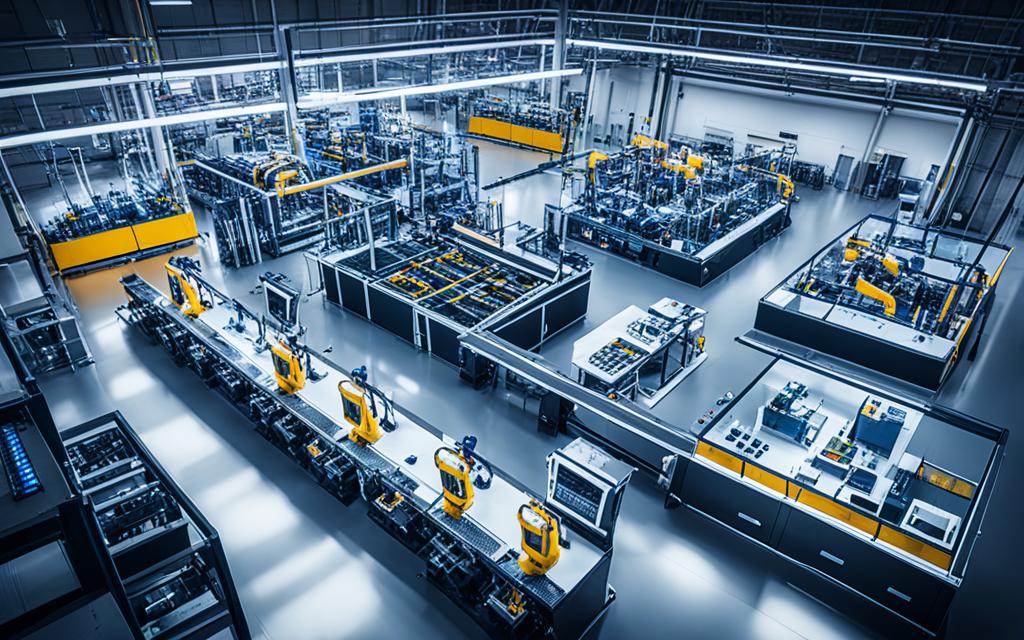
The Bastion of Boundless Beauty: Defending the Domain of Deluxe IoT Domains
The Internet of Things (IoT) and smart devices have revolutionized the way we live and interact with technology. From smart home devices to industrial applications, IoT solutions have become an integral part of our daily lives, connecting us to a world of endless possibilities. However, with this connectivity comes the need to understand and defend the domain of Deluxe IoT domains, ensuring the security, efficiency, and innovation of this rapidly expanding field.
In this article, I will delve into the intricacies of the IoT landscape, exploring the impact of IoT solutions on both personal and professional spheres. From defining the IoT landscape and its role in daily life to discussing architectural excellence and environmental intelligence, I will cover a wide range of topics that illuminate the transformative power of this technology.
Together, we will uncover the potential of IoT platforms in uniting devices and services, streamlining operations, and breaking down data silos. We will also explore the vanguard of IoT security, discussing effective measures to protect IoT devices and encourage consumer trust.
Furthermore, we will examine the critical role of IoT in maintaining financial stability and driving economic growth, as well as seizing market opportunities and catalyzing business growth through analytics, predictive maintenance, and real-time decision-making.
As we conclude, I will leave you with a vision of the future of IoT, highlighting the limitless possibilities that await us in this ever-evolving domain.
Key Takeaways:
- The Internet of Things (IoT) and smart devices have transformed various aspects of our lives, connecting us to a world of endless possibilities.
- Understanding and defending the domain of Deluxe IoT domains is crucial for sustainable growth and innovation.
- IoT solutions impact daily life, business sectors, environmental intelligence, efficiency, connectivity, and financial stability.
- Architectural excellence, IoT platforms, and IoT security are essential for reliable and efficient IoT systems.
- IoT technologies drive economic growth, business optimization, and provide market opportunities for various industries.
Embracing the Internet of Things (IoT) and Smart Devices Revolution
The Internet of Things (IoT) and smart devices have ushered in a revolutionary era of connectivity and convenience, transforming the way we live, work, and interact with technology. This section explores the landscape of IoT, its impact on daily life, the exponential growth it has experienced, and the technological advancements that have elevated our standards of living.
Defining the IoT Landscape and Its Impact on Daily Life
The IoT refers to the network of internet-connected devices that collect and exchange data, enabling seamless communication and automation. From smartphones and wearables to smart home devices and industrial sensors, the IoT has penetrated various aspects of our daily lives. By connecting disparate devices and integrating them into a unified system, the IoT empowers individuals and businesses to monitor and control their environments, optimize operations, and make data-driven decisions.
IoT applications have brought numerous conveniences to our lives. Smart home devices, such as thermostats, lighting systems, and security cameras, allow us to control and monitor our homes remotely. Wearable devices, like fitness trackers and smartwatches, enable us to track our health and fitness goals more effectively. IoT technology has also revolutionized industries such as healthcare, agriculture, transportation, and manufacturing, enhancing efficiency, productivity, and safety.
The Exponential Growth of IoT and Its Role in Modern Business
The IoT industry has witnessed exponential growth in recent years, fueled by the increasing adoption of smart devices and the advancements in IoT technology. As more devices become internet-connected, the potential for innovation and business opportunities expands. According to forecasts, the number of IoT devices is expected to reach billions in the coming years, as businesses and consumers embrace the benefits of interconnectedness and automation.
IoT growth has not only transformed consumer lifestyles but also revolutionized the way businesses operate. From supply chain management and asset tracking to predictive maintenance and customer insights, IoT applications have enabled businesses to optimize processes, improve operational efficiency, and unlock new revenue streams. By harnessing the power of IoT, businesses can gain a competitive edge by delivering personalized experiences, making informed decisions, and capitalizing on real-time data.
Technological Advances Elevating Standards of Living Through IoT
Technological advancements in IoT have played a pivotal role in elevating our standards of living and creating a more connected and intelligent world. The integration of advanced sensors, artificial intelligence (AI), and cloud computing has enhanced the capabilities of IoT devices, enabling them to collect, analyze, and act upon vast amounts of data in real-time.
With AI and machine learning algorithms, IoT devices can learn and adapt to user preferences, making our lives more efficient and convenient. For example, smart thermostats can adjust temperature settings based on occupancy patterns, optimizing energy usage and reducing costs. Intelligent virtual assistants, such as Amazon Alexa and Google Assistant, can understand and respond to voice commands, simplifying tasks and transforming the way we interact with technology.
Furthermore, IoT technology has facilitated breakthroughs in healthcare, allowing for remote patient monitoring, personalized treatment plans, and early detection of diseases. In agriculture, IoT-enabled smart farming techniques have improved crop yields, minimized water consumption, and ensured sustainable practices. The advancements in smart cities have paved the way for intelligent transportation systems, efficient resource management, and improved urban living conditions.
The integration of the Internet of Things (IoT) and smart devices has revolutionized the way we live and work. By connecting devices, collecting and exchanging data, and leveraging advanced technologies, the IoT has unlocked a world of possibilities for businesses and individuals alike. The next sections of this article will explore the architectural excellence of advanced IoT systems, the role of IoT in unlocking environmental intelligence, the impact of IoT solutions on efficiency, the synergy of connectivity through IoT platforms, and the importance of security in advancing IoT devices.
Architectural Excellence: The Blueprint of Advanced IoT Systems
In the realm of advanced IoT systems, architectural excellence plays a crucial role in shaping the foundation of seamless connectivity and efficient operations. The blueprint of IoT systems entails a well-designed infrastructure that allows for the interconnectedness of devices and seamless communication for data exchange.
“A well-designed architecture serves as the backbone of advanced IoT systems, ensuring their efficiency and effectiveness.”
The IoT architecture involves the integration of various components such as sensors, actuators, gateways, and cloud platforms, all working together harmoniously to enable the smooth flow of data and achieve optimal performance. Each component has a specific role in the overall system, contributing to its functionality and scalability.
One crucial aspect of IoT architecture is the establishment of robust data communication channels. These channels facilitate the transmission of data between devices and the cloud or other systems, enabling real-time monitoring, analysis, and decision-making.
“The interconnectedness of devices within an IoT system allows for the seamless exchange of data, paving the way for a multitude of applications and solutions.”
To ensure the reliability and security of IoT systems, the architecture must incorporate robust security measures. This includes authentication protocols, encryption techniques, and access control mechanisms to protect sensitive data and prevent unauthorized access.
An essential consideration in IoT architecture is the scalability and flexibility of the system. As IoT applications continue to expand and evolve, the architecture should be designed to accommodate future advancements, ensuring seamless integration with new devices and technologies.
By focusing on architectural excellence, organizations can harness the full potential of advanced IoT systems, unlocking innovative solutions and generating valuable insights from the vast amounts of data collected.

Key Components of a Well-Designed IoT Architecture
| Component | Description |
|---|---|
| Sensors | Collect data from the physical environment |
| Actuators | Enable actions and responses based on data inputs |
| Gateways | Facilitate communication between devices and the cloud or other systems |
| Cloud Platforms | Provide storage, processing, and analysis of data |
| Security Mechanisms | Ensure data protection and prevent unauthorized access |
With a solid architectural foundation, advanced IoT systems can pave the way for transformative applications and solutions across various industries, revolutionizing how we interact with technology and the world around us.
Unlocking Environmental Intelligence with IoT Innovations
In today’s rapidly evolving world, the Internet of Things (IoT) has emerged as a powerful force driving innovation and transforming industries. One area where IoT innovations are making a significant impact is in unlocking environmental intelligence. By leveraging interconnected devices and smart ecosystems, IoT technology is revolutionizing the way we monitor and optimize environmental conditions, leading to increased energy efficiency and sustainability.
Interconnected Devices and Their Role in Creating Smart Ecosystems
In the realm of environmental intelligence, interconnected devices play a vital role in creating smart ecosystems. These devices, equipped with sensors and actuators, work together seamlessly to collect and analyze data related to various environmental factors, such as temperature, humidity, air quality, and energy consumption. By establishing this interconnected network, IoT enables real-time monitoring and efficient management of environmental conditions.
For example, in smart buildings, IoT-enabled devices collaborate to regulate heating, ventilation, and air conditioning systems based on occupancy patterns and external weather conditions. This not only optimizes energy usage but also creates a comfortable and healthy environment for occupants.
IoT Contributions to Smart Home Devices and Urban Development
IoT has also made significant contributions to the development of smart home devices and urban infrastructure. By integrating IoT technology into various systems, homes and cities can be transformed into intelligent, sustainable environments.
Smart home devices equipped with IoT capabilities offer improved energy management, security, and convenience. Connected thermostats, for instance, can automatically adjust temperature settings based on occupancy, saving energy and reducing utility costs. IoT-enabled security systems allow homeowners to monitor their properties remotely, enhancing safety and peace of mind.
In urban development, IoT plays a pivotal role in creating smart cities that are environmentally friendly and efficient. IoT-connected devices and sensors enable the collection of real-time data, allowing city planners to make informed decisions about resource allocation, traffic management, waste management, and more. This holistic approach to urban development promotes sustainability and improves the quality of life for residents.
Overall, IoT innovations are revolutionizing environmental intelligence. By leveraging interconnected devices and smart ecosystems, IoT technology is improving energy efficiency, sustainability, and the overall quality of our living environment.
Illuminating the Path: IoT Solutions Lighting the Way to Efficiency
In today’s fast-paced and interconnected world, businesses and industries are constantly seeking ways to maximize efficiency, streamline operations, and optimize productivity. The Internet of Things (IoT) and smart devices have emerged as powerful tools that illuminate the path to efficiency, revolutionizing the way we work and live.
By leveraging IoT solutions, businesses can harness the power of automation and optimization to drive efficiency in various industries. Smart devices, equipped with sensors and connected to the internet, gather valuable data that can be analyzed and acted upon in real-time. This data-driven approach enables businesses to make informed decisions, identify bottlenecks, and implement process enhancements that result in increased efficiency and productivity.
Take, for example, the manufacturing sector. IoT solutions have enabled the implementation of predictive maintenance, where machines are equipped with sensors that monitor their performance. By analyzing the data collected, businesses can accurately predict when maintenance is required, minimizing downtime and reducing overall costs.
IoT solutions also play a pivotal role in optimizing supply chain management. With real-time tracking and monitoring of goods, businesses can ensure timely delivery, reduce wastage, and improve inventory management. This level of visibility and control allows for more efficient allocation of resources, reducing manual labor and human error.

The healthcare industry is another sector where IoT solutions are driving efficiency. Smart devices such as wearable health trackers and remote patient monitoring systems allow for continuous, real-time health data collection. This data can be closely monitored by healthcare professionals, enabling timely interventions and personalized care, ultimately leading to better patient outcomes.
In the retail industry, IoT solutions provide valuable insights into consumer behavior, enabling businesses to optimize their marketing strategies and improve customer experience. With IoT-enabled smart shelves and inventory management systems, businesses can automate inventory tracking, replenishment, and pricing adjustments, ensuring product availability and reducing operational costs.
It is evident that IoT solutions are transforming industries, empowering businesses to operate with unmatched efficiency and productivity. By embracing smart devices and IoT technology, businesses can unlock new opportunities, streamline operations, and achieve sustainable growth.
The future belongs to those who embrace the potential of the Internet of Things and leverage IoT solutions to illuminate the path to efficiency.
The Synergy of Connectivity: IoT Platforms Uniting Devices and Services
In the realm of the Internet of Things (IoT), the true power lies in the seamless connectivity between smart devices and services. This section explores the synergy created by IoT platforms, where devices and services come together to unlock a world of possibilities.
Breaking Down Data Silos Through Interoperability
One of the key challenges in the IoT landscape is the siloed nature of data generated by different devices. Without interoperability, these silos hinder collaboration and limit the potential for meaningful insights. However, IoT platforms bridge the gap by promoting interoperability, allowing devices and services to communicate effortlessly.
Through standardized protocols and open APIs, IoT platforms enable devices from various manufacturers to connect and share data seamlessly. This interoperability breaks down data silos, empowering businesses to harness the full potential of their IoT investments. Whether it’s a smart home system or an industrial IoT solution, interoperability ensures that devices work together harmoniously, facilitating efficient operations and enhancing user experiences.
Streamlining Operations with Robust IoT Data Management Systems
The success of any IoT deployment relies heavily on effective data management systems. IoT platforms offer robust tools and technologies for collecting, storing, and analyzing large volumes of data generated by interconnected devices. These data management systems are designed to handle the complexities of IoT data, ensuring its reliability, security, and accessibility.
IoT data management systems provide a centralized hub for processing and organizing data, allowing businesses to derive actionable insights from the vast amount of information. With the ability to collect real-time data from multiple sources, organizations can make informed decisions, optimize processes, and drive innovation. This centralized approach streamlines operations, enhances efficiency, and empowers businesses to stay ahead in today’s data-driven landscape.
The image represents the seamless connectivity and integration facilitated by IoT platforms, bringing together diverse devices and services for enhanced functionality and efficiency.
Vanguard of Security: Advancing IoT Devices with Ironclad Protection
In the rapidly evolving landscape of the Internet of Things (IoT) and smart devices, ensuring the security of these interconnected technologies is paramount. As IoT devices become more prevalent in our daily lives, protecting them from cyber threats and unauthorized access becomes a critical concern. Implementing effective IoT security measures is the vanguard of defense, safeguarding sensitive data and preserving the trust of consumers.
Implementing Effective IoT Security Measures
To protect IoT devices from cybersecurity vulnerabilities, it is crucial to implement robust security measures at every level. This includes:
- Ensuring secure communications: All data transmitted between IoT devices should be encrypted to prevent interception and unauthorized access.
- Implementing strong access controls: IoT devices should have strict authentication protocols to ensure that only authorized individuals can access and control them.
- Regular software updates and patch management: Keeping IoT devices up to date with the latest security patches is essential to address any known vulnerabilities.
- Segmentation of networks: Separating IoT devices from other networks can help contain potential breaches and limit the impact of attacks.
By implementing these security measures, IoT devices can be fortified against cyber threats, minimizing the risks of data breaches and unauthorized access.
Encouraging Consumer Trust Through Data Privacy and Compliance
Data privacy and compliance play a vital role in building consumer trust in IoT devices and services. As IoT devices collect and process vast amounts of personal data, it is imperative to prioritize the protection of this information. This can be achieved through:
- Transparency and user control: IoT devices should provide clear information about the types of data collected and enable users to have control over how their data is used.
- Compliance with regulations: Adhering to relevant data privacy regulations, such as the General Data Protection Regulation (GDPR), demonstrates a commitment to protecting user privacy.
- Data encryption and anonymization: Implementing strong encryption methods and anonymizing collected data can help safeguard user privacy even in the event of a data breach.
By prioritizing data privacy and compliance, IoT device manufacturers and service providers can establish a foundation of trust with their consumers, fostering long-term relationships and loyalty.

The image above illustrates the importance of IoT security in protecting interconnected devices and preserving data privacy.
In conclusion, the vanguard of security in the IoT domain lies in implementing effective security measures and prioritizing data privacy and compliance. By fortifying IoT devices with ironclad protection, we can ensure the safety and integrity of interconnected technologies and inspire consumer trust in the ever-expanding world of IoT.
The Global Economy’s Pulse: IoT’s Critical Role in Financial Stability
The Internet of Things (IoT) and smart devices play a critical role in maintaining financial stability and driving economic growth. Through the optimization of business operations, enhanced supply chain management, and improved resource utilization, IoT technologies have revolutionized various sectors, including manufacturing, logistics, and finance.
By leveraging IoT capabilities, businesses can optimize their operations and achieve greater efficiency, ultimately leading to increased financial stability. IoT devices enable real-time data collection and analysis, allowing businesses to make informed decisions and adapt their strategies accordingly. This level of business optimization can result in cost savings and improved profitability, enhancing the overall financial stability of organizations.
“IoT technologies have revolutionized various sectors, including manufacturing, logistics, and finance.”
In the manufacturing industry, IoT devices have facilitated automation and improved production processes. Smart devices connected through IoT networks enable real-time monitoring of equipment performance, predictive maintenance, and streamlined workflows. This not only increases operational efficiency but also reduces downtime and production costs, contributing to financial stability.
Logistics and supply chain management have also benefited from IoT integration. IoT-enabled tracking and monitoring systems provide real-time visibility into the movement of goods, optimizing transportation routes, and minimizing delays. By improving inventory management and reducing inefficiencies, businesses can enhance their financial stability and meet customer demands more effectively.
Furthermore, the finance industry has experienced significant transformations due to IoT technologies. IoT-powered financial services allow for seamless and secure transactions, enabling faster and more efficient payment processing. The integration of IoT devices in financial institutions also enhances fraud detection and risk management, ensuring greater financial stability and security.
The image below demonstrates the interconnectedness and optimization that IoT brings to the financial sector:
The critical role of IoT in maintaining financial stability and driving economic growth cannot be underestimated. Businesses that embrace IoT and harness its potential can achieve greater efficiency, improved resource utilization, and enhanced financial stability. As IoT continues to evolve and expand its influence, organizations must adapt to stay competitive in the ever-changing global economy.
Seizing Market Opportunities: IoT as a Catalyst for Business Growth
Businesses today are presented with unprecedented market opportunities through the integration and utilization of Internet of Things (IoT) technologies. As smart devices become more ubiquitous and interconnected, companies have the chance to leverage this wave of innovation to drive their growth and success.
Analytics and Predictive Maintenance as Drivers of Industrial Progress
Analytics plays a crucial role in leveraging the power of IoT. By collecting and analyzing data from smart devices, businesses can gain valuable insights into consumer behavior, market trends, and operational efficiency. This data-driven approach allows companies to make informed decisions and tailor their products and services to meet the evolving demands of the market.
Predictive maintenance is another game-changing application of IoT that drives industrial progress. By utilizing sensors and real-time data from IoT devices, companies can implement proactive maintenance strategies, minimizing downtime and maximizing productivity. Predictive maintenance enables businesses to identify and address potential equipment failures before they occur, saving them valuable time, resources, and costs.

Smart Device Integration and Real-Time Decision Making
Integrating smart devices into existing business processes is essential for harnessing the full potential of IoT. Through smart device integration, businesses can capture and analyze vast amounts of data in real-time, enabling them to make informed and timely decisions. Real-time decision making empowers companies to respond rapidly to market changes, optimize operations, enhance customer experiences, and gain a competitive edge.
Furthermore, smart device integration opens up new avenues for innovation, allowing businesses to create personalized and immersive experiences for their customers. From smart home devices that enhance comfort and convenience to wearable technologies that track health and fitness, IoT-enabled products and services are reshaping industries and driving customer satisfaction.
As IoT continues to evolve and expand, businesses must seize the market opportunities presented by this technology revolution. By leveraging analytics, predictive maintenance, and smart device integration, companies can achieve sustainable growth and stay ahead in today’s competitive landscape.
Conclusion
Throughout this article, we have explored the vast potential of the Internet of Things (IoT) and smart devices in driving technology innovation and transforming various industries. The IoT landscape has come a long way, connecting internet-enabled devices and revolutionizing the way we live and work.
The future of IoT holds limitless possibilities. As technology continues to advance, we can expect even greater integration of smart devices into our daily lives. From smart home devices and energy-efficient solutions to industrial automation and predictive maintenance, IoT will continue to shape the way we interact with our surroundings.
It is vital for businesses and individuals to embrace this revolution and seize the opportunities it presents. The IoT domain offers a world of innovation and growth, enabling us to optimize processes, enhance efficiency, and create sustainable solutions. By leveraging IoT technologies, we can unlock new avenues for success and drive positive change in our society.
As we move forward into the future, let us embrace the boundless potential of the IoT domain. By continually exploring and investing in IoT technologies, we can contribute to a world that is interconnected, efficient, and sustainable. Together, let us shape the future, where IoT and smart devices propel us towards a technologically advanced and interconnected world.
FAQ
What is the Internet of Things (IoT)?
How does the IoT impact daily life?
What is the role of the IoT in modern business?
How does IoT architecture work?
How does the IoT contribute to environmental intelligence?
What are some real-world examples of IoT solutions?
Why is interoperability important in IoT platforms?
How does IoT security protect against cyber threats?
How does the IoT contribute to financial stability and economic growth?
How can businesses seize market opportunities with IoT technologies?
Source Links




